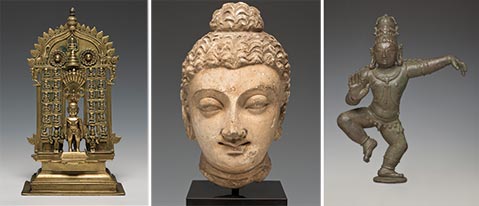‘Puja and Piety’ at the Santa Barbara Museum of Art
Innovative Survey Looks at Hindu, Jain, and Buddhist Artworks as Aids to Devotion

For 75 years the Santa Barbara Museum of Art has pursued a mission that includes collecting, displaying, and educating the public about the arts of Asia. Puja and Piety: Hindu, Jain, and Buddhist Art from the Indian Subcontinent demonstrates the impact that an innovative curatorial concept can have on the educational component of this project. Rather than trust the traditional triad of period, location, and style in organizing this large survey (more than 150 objects), the team behind Puja and Piety has chosen instead to employ an approach that focuses on puja, the acts of worship and propitiation that are common to Hindu, Jain, and Buddhist cultures. Objects and images from many different times and places within the Indian subcontinent are displayed together to illustrate different types of devotion, from Buddhist stupa circumambulation to Hindu feast day processions to the daily worship conducted within Jain homes at private household shrines.
Released from the burden of testing and proving some implied narrative of cultural development, visitors can roam these galleries in search of the varieties of puja that resonate for them. Admirers of ancient Greek sculpture will be thrilled by the elegant figures of Buddha on view from Hellenistic Gandhara, now Pakistan. Stone carvers in the first five centuries CE employed representational strategies borrowed from Greek and Roman models to create the first anthropomorphic images of the Buddha and then the bodhisattvas who followed him. Rich in naturalistic detail, these images nevertheless project a powerful sense of the detachment and serenity that have come to be the most commonly understood aspect of Buddhism worldwide.
Less well-known but equally rich in visual aids to puja, the Jain religion grew up at roughly the same time as Buddhism. The Jains worship 24 enlightened beings known as Jina, the most recent of whom, Vardhamana Mahavira, lived approximately 2,500 years ago and is known to have been an elder contemporary of Siddhartha Gautama, the Buddha. A divinely inspired 11th-12th century monk named Hemachandra codified Jain puja in relation to icons that have ever since been traditionally located and venerated inside the Jain household. Several of these exquisite small altarpieces executed in a variety of precious metals and gilt brass are on display, and they are a revelation. Specific Jinas are depicted facing forward and are often either flanked by highly symmetrical images of the other 23 holy figures, canopied by the hoods of multiple cobras, or both. These Jain altarpieces are particularly notable for the way that they introduce a physical gesture known as the posture of “body abandonment,” a position in which the arms are held loose from the torso and which is said to indicate the renunciation of worldly things.
For embodying the distinctive charm of a religious practice that’s more open to the pleasures of this world, it’s hard to beat the dancing Krishnas of Hinduism. These processional images are made to be mounted on giant wooden carts and transported through the streets on festival days, adorned with expensive clothing and jewels, but they make an indelible impression all by themselves, as can be seen in the 13th-century “Dancing Child Krishna” from Tamil Nadu, or any one of several other such figures created between the 13th and the 19th centuries. Remarkable, as well, for its vitality is the 18th-century “Monumental Head of Hanuman” from Kerala, which represents the simian devotee of Rama who helped this Hindu hero overcome his rival Ravana. Admiring this and other representations on display of the trusty Hanuman, I could not help but wish that Hillary Clinton will be blessed with a similarly effective sidekick, simian or otherwise, in the months to come.
Puja and Piety shows at the Santa Barbara Museum of Art (1130 State St.) through August 28. Call (805) 963-4364 or visit sbma.net.



